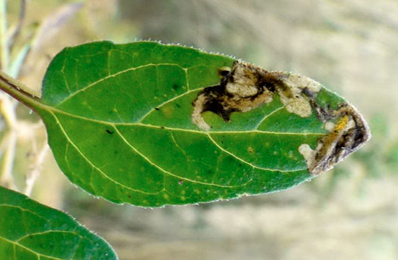|
||||||
|
Orthochaetes
insignis (Aube, 1863) Styphlus
insignis Aube, 1863 |
|
|
Leaf-miner: Rather narrow corridor, untidy and sometimes branched, starting from the base of the leaf, in particular the midrib. Sides of the corridor irregularly eaten out, not really parallel. Frass mostly present, and then in a central line. The larva is capable of leaving the mine and start a new one elsewhere. These later mines are much broader, and the frass is scattered irregularly (Bladmineerders van Europa).
Larva: The larvae of beetles have a head capsule and chewing mouthparts with opposable mandibles and lack abdominal legs. The larvae are legless. (see Keys in Bladmineerders van Europa). Pupa: The pupae of beetles have visible head appendages, wings and legs which lie in sheaths (see examples). Hosts in Great Britain and Ireland: Currently unknown. Hosts elsewhere: Time of year - larvae: Almost throughout the year (Hering, 1957). Time of year - adults: Currently unknown. Distribution in Great Britain and Ireland: Widespread in Britain including Bedforshire, Berkshire, Buckinghamshire, Cardiganshire, Carmarthenshire, Cheshire, Cumberland, Derbyshire, Dorset, Dumfireshire, East Cornwall, East Kent, East Norfolk, East Suffolk, Glamorgan, Herefordshire, Kirkudbrightshire, Leicestershire, Merionethshire, Mid-west Yorkshire, Middlesex, Monmouthshire, Montgomeryshire, North Essex, North Devon, North Somerset, Northamptonshire, Nottinghamdshire, Pembrokeshire, Radnorshire, Shropshire, South Hampshire, South Lancashire, South Somerset, South Wiltshire, South-west Yorkshire, Stafford, Surrey, Warwickshire, West Gloucestershire, West Kent, West Norfolk, West Suffolk, West Sussex, Westmorland and Worcestershire (NBN Atlas). Also recorded in the Republic of Ireland (Fauna Europaea) and in Ireland (InvertebrateIreland Online). Distribution elsewhere: Widespread in continental Europe inlcuding Corsica, French mainland, Italian mainland, Portuguese mainland, Sardinia, Sicily, Spanish mainland. Also recorded in North Africa (Fauna Europaea). NBN Atlas links to known host species: British and Irish Parasitoids in Britain and elsewhere: Currently unknown. |
|
|
|
| External links: | Search the internet: |
|
Biodiversity Heritage Library |
Find
using Google Find using Google Scholar Find images using Google |
| Last updated 08-Jul-2019 Brian Pitkin | ||

